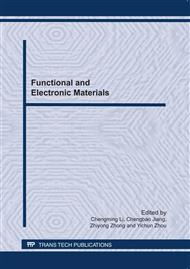[1]
A. Shanmim, J. Bray, L. Roy et al. Microwave and Magnetostatic Characterization of Ferrite LTCC for Tunable and Reconfigurable SiP Application. University of Electronic Science and Tech of China. 691-694 (2010).
DOI: 10.1109/mwsym.2007.380014
Google Scholar
[2]
R. L. Brown, P. W. Polinski. The integration of passive components into MCM's using advanced low-temperature co-fired ceramics. Int. J. Microcirc. Electron. Packag, 328~338 (1993).
Google Scholar
[3]
Micheal Richtarsic, Jack Thornron. Characterization and Optimization of LTCC for High Density Large Area MCM's. IEEE. 92~96(1998).
Google Scholar
[4]
Calina Kniajer, Kentor Dechant, Drasad Apte. Low loss, low temperature cofired ceramics with higher dielectric constants for multichip modules (MCM). IEEE. Trans. Microwave. 121~128(1997).
DOI: 10.1109/icmcm.1997.581159
Google Scholar
[5]
Yu Ron, Kawthar A. Zaki. Low-Temperature Cofired Ceramic (LTCC) Ridge Waveguide Bandpass Chip Filters. IEEE Trans. Microwave. 2317~2322(1999).
DOI: 10.1109/22.808977
Google Scholar
[6]
Z. Simsa, S. Lego, R. Gerber. Cation distribution in Co-Ti-substituted barium hexaferrites. Journal of Magnetism and Magnetic Materials. 2103~2104(1995), p.140.
DOI: 10.1016/0304-8853(94)01393-4
Google Scholar
[7]
J. Williams, J. Adetunji, M. Gregori. Mossbauer spectroscopic determination of magnetic moments of Fe3+ and Co2+ in substituted barium hexaferrite Ba (CoTi)xFe12-2xO19. Journal of Magnetism and Magnetic Materials. 124~128(2000), p.220.
DOI: 10.1016/s0304-8853(00)00458-3
Google Scholar
[8]
Xiaoyu Sui, Mark H. Kryder, Effects of CoTi-doping on Longitudinal Barium Ferrite Thin Film Media, IEEE TRANSACTIONS ON MAGNETICS. 4044-4046(1994).
DOI: 10.1109/20.333984
Google Scholar
[9]
Sherin Thomas, Mailadil Thomas Sebastian. Effesct of Bi2O3-Bi2O3-SiO2-ZnO glass on the sintering and microwave dielectric properties of 0. 83ZnAl2O4-0. 17TiO2. Materials Research Bulletin. 843-851(2008), p.43.
DOI: 10.1016/j.materresbull.2007.05.015
Google Scholar
[10]
H. -I. Hsiang, T. -H. chen. Electrical properties of low-temperature-fired ferrite-dielectric composites, Ceramics International. 2009, doi: 10. 1016/j. ceramint. 2008. 11. 004.
DOI: 10.1016/j.ceramint.2008.11.004
Google Scholar
[11]
C. Fredericci ,H.N. Yoshimura, et al. Effect of TiO2 addition on the chemical durability of Bi2O3-SiO2-ZnO-B2O3 glass system. Journal of Non-Crystalline Solids. 4777-4785(2008), p.354.
DOI: 10.1016/j.jnoncrysol.2008.04.026
Google Scholar
[12]
G.B. Teh, N. Saravanan, D.A. Jefferson. A study of magnetoplumbite-type (M-type) cobalt–titanium-substituted barium ferrite, BaCoxTixFe12-2xO19 (x=1-6). Materials Chemistry and Physics. 253–259(2007), p.105.
DOI: 10.1016/j.matchemphys.2007.04.054
Google Scholar


